From little things big things grow. Emerald & District Co-op operating in the Dandenong Ranges since 1945.
In 1944 Emerald was a small hills town, linked to Melbourne via Ferntree Gully by the narrow gauge railway. Two thirds of the surrounding land was still virgin bush. A small range of shops supplied the needs of local residents, and farmers, nurseryman, orchardists and market gardeners in the surrounding district. On the Monbulk Road corner George Ellwood kept the store, first opened in 1901. Across the road was a butcher’s shop. At the other end of town there was another butcher, a fruiterer and a bakery. The Mechanics Institute and Public Hall provided a focus for community gatherings, and a wine salon, Hogan’s tearoom, and several guest houses – among them La Belle, Nottingham House and Lumeah – provided for the social life of visitors and locals. Three churches and the primary school in Heroes Avenue catered for spiritual and educational needs, while a police station helped to keep citizens law-abiding. Emerald Lake Park – a remnant of the renowned Nobelius Nursery, still operating but on a much reduced scale – provided for summer leisure needs.
Emerald, along with the rest of Australia, had been hit by the privations of World War II. By 1944 a shortage of stock feed had created a desperate situation for local farmers, who still used horses to cultivate their land. At a meeting at the Emerald Mechanics Institute on 9 December 1944, those present, J.L. Hirst, R.W. Nobelius, H.R. Wardle, H. Wise and J. Eudey, agreed that the solution was to form a co-operative society in Emerald. Jack Eudey was elected Chairman, Horrie Wardle was appointed Secretary, and Jack Hirst Manager.
"What we need is a courageous spirit and a co-operative effort”
‘We are beginning in a small way . . .’ Emerald resident Harry Wise was addressing a gathering of Emerald farmers. The first meeting of the Board of Directors of the Emerald and District Co-operative Society was, indeed, a small beginning, and one that would need, Wise continued, ‘a courageous spirit and co-operative effort’. There was much optimism – an optimism that would in due course become a passion – but sixty years ago the Directors could scarcely have imagined the modern store that would flourish from the seed they were planting, nor the challenges that lay ahead.
This gathering of Emerald farmers was following a century-old tradition. The co-operative movement grew out of the industrial revolution in Britain when working people, whose wages scarcely afforded them the basic necessities of life, banded together to buy goods at wholesale prices.
Co-operative societies are governed by an Act of Parliament and Emerald Co-operative Society had to conform to legislation. The first task was to adopt rules and to register the society. Co-operatives have a philosophy that is quite different from other types of business organisations. Membership is open to anyone over the age of eighteen on the purchase of one or more shares. In decisions taken by members, each shareholder has one vote, and only one vote, regardless of the number of shares held. Capital raised by shares is intended to serve the activities of the co-operative, rather than provide an individual return to members, although any surplus not needed for payment of accounts, improvement of services or development of the business may be distributed to members in proportion to their purchases from the co-operative. The Emerald Co-operative Society incorporated all of these principles into its rules.
Management of the Society’s affairs was vested in a board of seven elected members of the Co-op. The first Directors were Harry Wise, Jack Hirst, Harry Beazley, S. Gibson, Jack Eudey, R.W. Nobelius, and Cr Tom Merritt. By the first Board meeting, held on 24 May 1945, the Directors had approved an application from Mr P. Cowper for one ₤5[1] share, from which it paid the ₤3 registration fee, opened an account in the Friendly Societies Section of the Commonwealth Bank, purchased account books and arranged signage and printing of booklets. The Board resolved to meet on the third Thursday of every month in the Emerald Mechanics Institute supper room.
An early priority was to raise share capital to purchase stock. At first there was some suspicion about the idea of a co-operative in Emerald – even allegations of communist influence. To reassure both residents and traders, Directors moved at a meeting in June 1945 ‘that the Emerald and District Co-operative Society strongly supports the local merchants on behalf of the community’. Suspicion abated and a regular item at board meetings became the approval of share applications. By mid-1945 the bank balance had grown from its opening sum of ₤1.10.0 to ₤165.6.4 and the Emerald and District Co-operative was to become an integral part and a significant contributor to Emerald and its surrounding communities to this very day..
*An abridged history and timeline of the Emerald and District Co-operative Society adapted from ”A history of the Emerald and District Co-operative Society” by Jo Jenkinson for the Emerald Museum.



